Quantum entanglement is one of the more confounding yet captivating phenomena in the realm of physics. Understood as a link between particles that defies classical concepts of distance and separation, entanglement has captured the imagination of scientists and the public alike. In simplistic terms, entangled entities can exhibit correlations that seem to transcend the limits of space. This concept, often illustrated through photons, recently expanded its reach through groundbreaking experiments at the Large Hadron Collider (LHC) in Geneva, confirming the existence of entangled top quarks—an achievement with profound implications for our understanding of the quantum world.
Understanding Entanglement
At its core, entanglement challenges our conventional views of physical connection. Think of two balls—one tossed into the air, the other placed at a distance of a kilometer. In our everyday understanding, they exist independently. However, when two particles are entangled, measuring one instantaneously informs us about the state of the other, regardless of the distance separating them. This phenomenon is not merely a theoretical construct; it has been validated through various experiments involving photons across expansive distances. Popular culture has invoked entanglement too, as seen in the Netflix adaptation of Liu Cixin’s “3 Body Problem,” where alien entities manipulate technology using entangled supercomputers light-years apart. However, it is crucial to note that entanglement does not permit faster-than-light communication, adhering to the constraints posed by quantum physics.
Recent Discoveries at the Large Hadron Collider
In a significant advancement reported in a recent paper published in the prestigious journal *Nature*, researchers at the ATLAS experiment at the LHC have documented entanglement involving pairs of the top quark. This particle, the heaviest known elementary particle, presents a unique opportunity for scientists hoping to unveil new phenomena in particle physics. Historically seen in lighter particles like photons and atoms, this emergence of entanglement in top quarks enriches our understanding of quantum interactions under conditions of extreme energy. While entanglement can falter under perturbations due to its fragile nature, the LHC provides an environment where such forces can be controlled, allowing for substantial measurements of these entangled states.
The top quark, which exceeds the mass of a proton by approximately 184 times, stands as an object of intense scrutiny within the scientific community. This colossal mass raises several inquiries about its fundamental nature. One line of thought suggests that its substantial mass could imply the presence of undiscovered forces interacting with it, hinting at new physics yet to be tapped. Such theories beckon for extensive investigation to comprehend the intricate tapestry of forces shaping not only the top quark but also the fabric of the universe.
Despite the promising implications of this research, the path toward practical applications in technology remains daunting. The heft and complexity of the LHC imply that while insights garnered from top quark entanglement might not yield direct technological advancements akin to those envisioned with quantum computing, they could pave the way for deeper understanding of quantum behaviors. The fragility of quantum states necessitates experimentation under highly controlled conditions—largely achievable in laboratory settings but challenging in practical applications. Thus, top quarks may not lead to portable quantum technologies; rather, they enrich our scientific discourse surrounding quantum mechanics.
The Future of Quantum Research
The discoveries surrounding top quark entanglement bring us one step closer to comprehending the enigmatic dimensions of the quantum realm. Researchers continue to explore these connections, probing deeper into the fundamental laws of physics, which we recognize are currently incomplete. The quest for new physics, intertwined with the intricacies of particle interactions, may ultimately unveil more secrets of the cosmos.
As our pursuit of understanding evolves, the role of entanglement will undeniably shift from abstract theoretical discourse to applicable science, framed by ongoing discoveries. The entangled relationships between particles like top quarks signal a transition into deeper realms of inquiry, anchoring our knowledge of an undeniably complex universe. Future explorations promise to yield insights that might redefine our comprehension of reality itself, thereby cementing entanglement’s position as a linchpin in the machinery of modern physics.


Leave a Reply